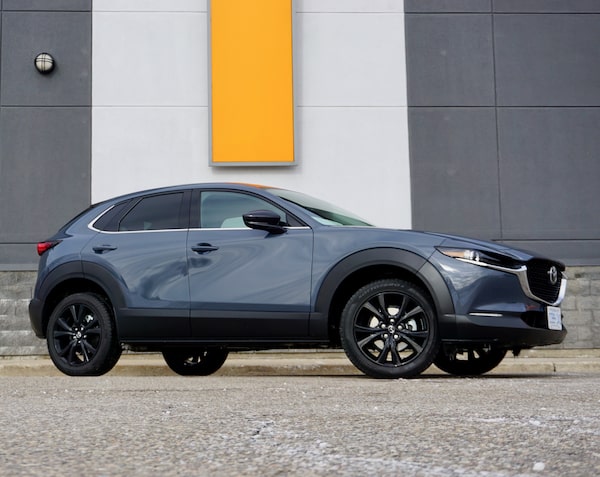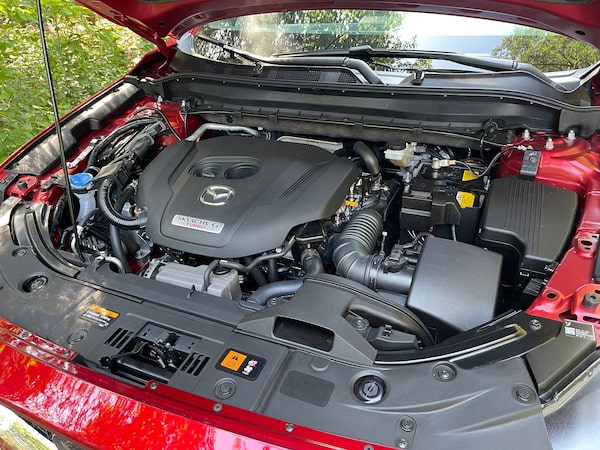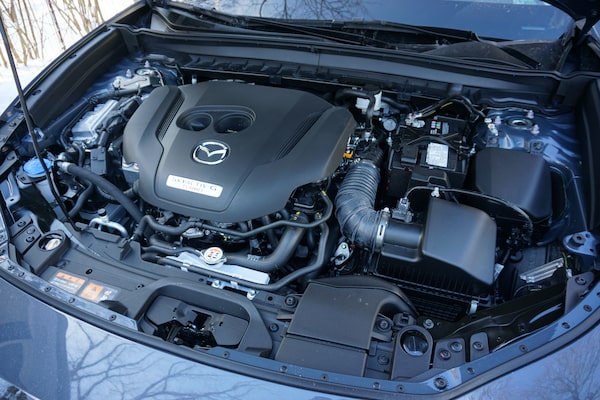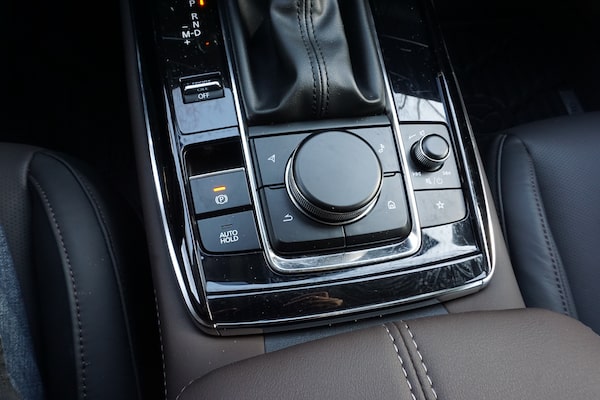
The 2021 Mazda CX-30.Jeremy Sinek/The Globe and Mail
The compact Mazda CX-5 and its one-size-down sibling, the CX-30, share many features, but they differ in many ways too. It’s not just about the size but also the entire feel of the drive. Both are now available with Mazda’s peppy 2.5-litre turbocharged engine, which comes at a price but turns both cars into more powerful SUVs.
I drove the turbocharged CX-30 and afterward I couldn’t wait to get into its bigger cousin, the turbocharged CX-5. The little CX-30 felt so well put together that I looked forward to driving it, and I’d take the longer route to get places. I can’t say that about most of the vehicles I drive.
It’s a hefty premium for the turbo engine. You can buy a front-wheel drive CX-30 GX with an anemic 2.0-litre engine starting at $26,200, but if you want the 250 horsepower, you have to buy all the bells and whistles of the GT upgrade, which lists for $34,000, and then add the turbo for an extra $2,400. You won’t get out the door, after taxes, for less than $43,000. That’s a lot for a subcompact SUV.

The 2021 Mazda CX-5 Turbo.Mark Richardson/The Globe and Mail
The story is similar for the CX-5, which has a basic sales price of $28,950, but the turbo comes near the top of the trim ladder and lists for $40,500. Once you add in the $1,950 for Mazda’s various destination fees, and all the taxes you’ll pay (unless you’re in sales-tax-free Alberta, of course), you’ll be looking at more than $47,000.
Are they worth it? Here’s a spoiler: The CX-30 is; the CX-5 isn’t.
Tech specs
2021 Mazda CX-30 GT Turbo
Base price/as tested: $36,250/$36,450, plus $1,950 freight and delivery
Engine: 2.5-litre turbocharged inline-four
Transmission/drive: Six-speed automatic/all-wheel drive
Fuel economy (litres/100 kilometres): 10.5 city/7.9 highway
2021 Mazda CX-5 Turbo
Base price/as tested: $40,500/$43,200, plus $1,950 freight and delivery
Engine: 2.5-litre turbocharged inline-four
Transmission/drive: Six-speed automatic/all-wheel drive
Fuel economy (litres/100 kilometres): 10.8 city/8.7 highway
Looks
Both models share Mazda’s attractive design, with shallow headlights and tail lights, and a non-offensive grille. The smaller CX-30 has a coupe-like shape that seems a little sportier, while the CX-5 is a good-looking SUV.
The CX-30 has black cladding at the base of its doors that could easily have been awful (remember the Pontiac Aztek?). In this case, though, the cladding is a little taller at the back than the front and adds a sensation of moving forward. Mazda says it makes the body look like “it’s floating on the wheels, giving the vehicle a light and agile character.” That seems a bit purple to me, but the whole approach to the profile does work in a more dynamic way than the straightforward CX-5.
Interior
Both cars are very comfortable. In fact, I’d rate the seats as more comfortable than those on the BMW 4 Series I drove recently, and I’d happily make a long-distance journey in either of them. There’s a little more space all around in the larger CX-5, of course, particularly in the second row, though neither feels cramped. Both are reasonably tall, too, for easier access and better sightlines on the highway.
The CX-30 has a smaller 8.8-inch screen that is not touch sensitive.Jeremy Sinek/The Globe and Mail

The CX-5 Signature tester (basically the same as the GT Turbo, but with every bell and whistle) comes only with 'cocoa nappa leather.'Mark Richardson/The Globe and Mail
I found the interiors of both Mazdas to be too monochromatic for my taste. The CX-30 GT and the CX-5 GT are both available with either black or white leather, and the black leather of the smaller tester was just a bit too much black. The aluminum and wood trim helped on the doors and black dashboard panels, but I’d have liked more contrast. The CX-5 Signature tester (basically the same as the GT Turbo, but with every bell and whistle) comes only with “cocoa nappa leather,” but to my eyes, it just looked like more black.
The CX-5 is now available as a 2021.5 model, which means it’s been freshened up midway through the model year. Mostly, some safety options are now standard and different options have been added at the various lower trim levels. Its centre display screen is now larger, at 10.25 inches, but it’s not touch sensitive and must be controlled through a rotary dial on the centre console; the CX-30 still has a smaller 8.8-inch screen and is also not touch sensitive.
Performance
This is where it all comes together. Both cars have the same optional turbocharged engine, which makes 250 horsepower and 320 lb-ft of torque that kicks in at 2,000 rpm. This is with superpremium 93 octane gas (premium is 91 octane), for which thrifty Mazda owners are unlikely to pay the extra 30 cents a litre. Put regular fuel in and the engine is good for a healthy 227 horsepower and 310 lb-ft.
This engine fitted into the CX-30 like a glove, and it was wonderful. I rarely say this, but the car felt like an extension of me when I drove it – like a car version of those giant robots in Avatar that people sit inside and use as vastly more powerful versions of themselves. I looked forward to driving it and flipping the paddle-shifters up and down through the six gears. When I turned a corner, it was as if it was just me, and the tight little car was responsive to my every thought. It was terrific.

The CX-5 is now available as a 2021.5 model, which means it’s been freshened up midway through the model year.Mark Richardson/The Globe and Mail

The optional turbocharged engine fits into the CX-30 like a glove.Jeremy Sinek/The Globe and Mail
In the CX-5, however, it was just a more powerful engine in a vehicle that weighed an extra 142 kilograms. Both models are also sold with a naturally aspirated 2.5-litre inline four-cylinder engine that produces 187 horsepower and 186 lb-ft of torque at a lofty 4,000 rpm, and that powerplant is fine for both sizes. The turbo version is definitely better than the basic 2.0-litre engine in the regular CX-30, but you won’t drive it and think, wow! In the bigger CX-5, you don’t think wow! with the turbo engine either. I don’t think I touched the paddle shifters once in the CX-5. It’s not even stronger for towing – both the turbo and non-turbo 2.5s are rated for only 2,000 lbs.
Technology
For such similar vehicles from the same maker, I don’t know why they don’t have identical standard features. When you’re buying the top-of-the-line turbos, though, most of the model options are standard.
The Signature trim level is intended to be Mazda’s premium edition with an emphasis on luxury. However, the larger screen is still smaller than the 12.1-inch high-definition touch screens of many competitors, and the cover for the comparatively small moonroof is manually (though, easily) operated, and there is no wireless charging for your smartphone.

The Signature trim level is intended to be Mazda’s premium edition with an emphasis on luxury.Jeremy Sinek/The Globe and Mail
The CX-5 includes lane-keeping assistance, so it will keep the vehicle in its lane if you take your hands off the wheel for a short time. Or at least, it’s supposed to. It would only beep at me as it wandered off toward the ditch. In discussion with the Mazda public relations rep about this, it’s possible I’d switched off the feature but I’m not convinced.
The CX-30 has the smaller screen but it doesn’t seem such a big deal in a smaller car. The information on the screen is relatively limited, anyway. Wireless charging for your phone is a $382 dealer-installed option.
Cargo
There’s more space in the CX-5, of course, with 875 litres behind the 40/20/40 rear seats and 1,687 litres when those seats are folded flat. The CX-30 is a bit more of a Tardis, though, more than doubling its capacity of 572 litres to 1,280 when the seats are down.

The CX-5 has more cargo space than the CX-30.Mark Richardson/The Globe and Mail
If you think of the CX-5 as a compact SUV, then its capacity is about average – and it does include a spare wheel. If you think of the CX-30 as more of a hot hatch, which I came to do, then its capacity is very generous.
The verdict
If you’re thinking about the CX-30 and you love to drive, then go for the turbo and damn the expense. It’s a sheer pleasure and will not disappoint. If you need more space and you’re thinking about the CX-5, don’t bother with the turbo, whether you love to drive or not. Get the naturally aspirated engine in the GS or Kuro trims, settle for a regular drive with better fuel consumption and save yourself as much as $10,000.
Shopping for a new car? Check out the new Globe Drive Build and Price Tool to see the latest discounts, rebates and rates on new cars, trucks and SUVs. Click here to get your price.
 Mark Richardson
Mark Richardson